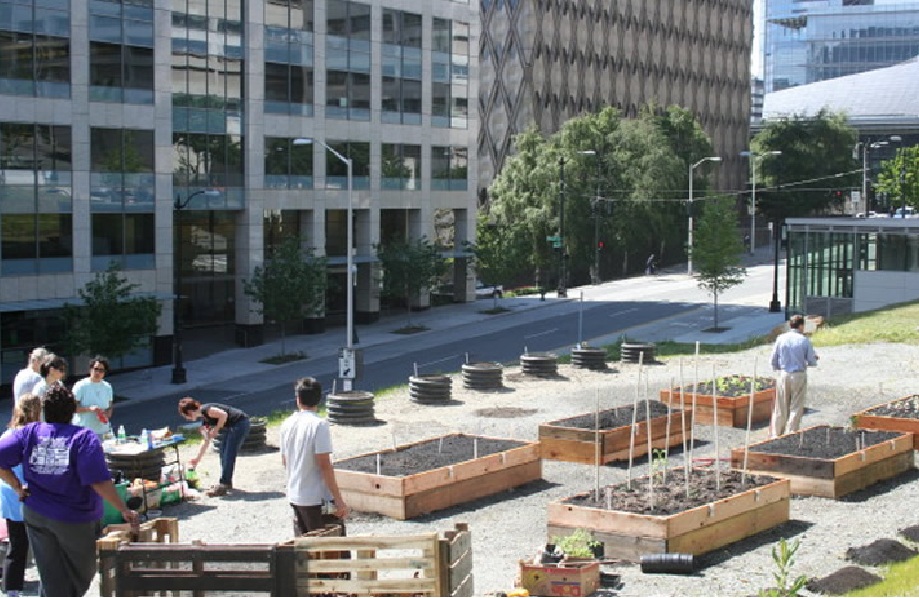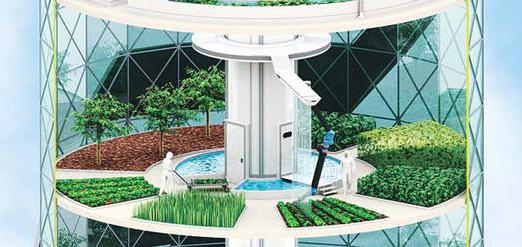Premises
20% of undernourished people live in cities (Shaw, p 395). In these urban areas, many people are going hungry due to monetary factors such as unemployment and high housing costs (Mayors, 2010). Around the world, nonprofit organizations such as food banks are attempting to feed the hungry by directly giving them food as an immediate relief to under-nutrition. However, these organizations are not able to supply the growing demand from over 185 million hungry people (FAO, 2010 and Shaw, p 395). Urban agriculture can help supply food to undernourished populations in cities as one alternative to an increased import of produce. In discussing the benefits of this implementation, intra-urban and peri-urban areas will be examined. Then, the innovation of vertical farming will be introduced.
Within Cities:
Even in developed nations, hunger is a huge issue. In the United States, 50 million people are food-insecure (Feeding America, 2009). In Europe, there are 30 million undernourished people (FEBA, 2010). A cheaper source of healthy goods is possible through urban agriculture. Urban agriculture in many places exists as either for-profit businesses or community gardens. Unused city plots can be turned into efficient growing spaces. There are many different methods of urban agriculture that have shown success in generating fresh, local produce, but most of these currently do not directly feed the hungry populations. The strategies/methods of growing food in and around cities are fairly straight-forward, and have in many cases have generated jobs, improved livelihoods, and fed more people.
In more developed and economically advanced cities, such as in the US, a cheaper source of healthy goods is possible through urban agriculture. Many people cultivate plots as small as 500 square feet in cities for profit, so if implemented by non-profits, more food could be provided to the needy. The target would be the extremely impoverished, homeless, at-risk etc already being targeted by food banks and meal programs.
In Detroit alone, there are 1300 community gardens, and the urban agriculture effort is growing (Carmody, April 2010). A single community garden of 9 raised beds and 10 round planters can produce 250 pounds of food in one year (King County, 2010).
Food banks/local nonprofits would use a small plot of land to grow food to supply their own programs/stock their own shelves. Because renting space in a city would likely be too costly to financially sustain an urban garden, an organization could easily invest in a small piece of land or enter an agreement with the owner of an unused plot, exchanging its upkeep for its use. After a few years, urban agriculture would provide a cheaper source of produce because there is very little distribution involved, as well as no 'middle man.' Food can be directly distributed to markets, food banks, and other programs. To also maximize efficiency and minimize input costs, the organization should also use organic methods of fertilization such as composting.
Materials and preparation to start fresh on a .5 acre (21,000 sq ft) plot would cost about $25,000 (Deforest, Little City Gardens). Not included is the cost of transportation, education, and labor. However, this type of program could have a positive feedback effect. Those who such a program would serve, such as the unemployed, homeless, children etc., could provide much of the labor, as well as regular staff and volunteers. Regarding transportation, if the plot is nearby, no vehicles/fuel need be involved; yet if need be, transportation costs could be minimized through the use of a volunteer’s truck or pre-existing organization’s vehicle. Other investments may include a walk-in cooler and additions to/remodelling of buildings. The organization would be responsible for procuring their own funding, through grants, events, and traditional donations.
In under a year, a portion of a plot can have seen a test-run of urban agriculture. Efforts in the second through fourth years would be to see what works in terms of species grown, evaluate agricultural methods, and develop a financial plan. Although new ideas, experiments and obstacles will continue to be presented indefinitely, it should only take a few years for an urban garden to become fully operational and produce enough to feed many people “feed many people” is really vague. How many people matters? Will it be worth putting that much money and effort into it? -still be thinking about it from the first part about community gardens.See above part on community garden
Unfortunately, most cities do not currently provide any funds or subsidized materials for urban agricultural start-ups, so widespread development in some areas may be delayed by high costs.

The building of the Goat Hill Giving Garden, King County, WA.
Source: http://your.kingcounty.gov/employees/Garden/PhotoGallery/gallery.swf
Around cities:
Developing nations such as China and India have a greater number and density of undernourished peoples in cities. China houses 22% of the world's population yet only contains 7% of the world's arable land (SCMP, p. 8). India's population is predicted to grow to around 2 billion by 2100 (Population Foundation of India, 2007). In developing nations, it is often the case that there is not an abundance of unused land within a city. However, the land immediately outside the city, or urban fringe, is typically fertile and easily cultivatable. Peri-urban (urban fringe) agriculture, if implemented on a broader scale, has the potential to create jobs and feed the under-nourished. The Resource Centers of Urban Agriculture and Food Security Foundation (RUAF) has been able to connect local agricultural universities, industries, cooperatives, local governments, migrant farmers, and consumers in many developing cities.
In Chengdu, China, the efforts of the RUAF and Chengdu Municipality have generated agricultural pilot projects that have expanded from successes in Beijing. Funding has been invested by RUAF and its many partner organizations to implement organic agriculture and develop village-based cooperatives. Shanghai, 60% of vegetables, 90% of eggs, and 800,000 jobs originate from urban areas and urban fringe (Ryerson University). Furthermore, intra-urban agriculture is a growing agro-tourism industry. Attractions such as pick-your-own-fruit, fishing, and lodging generates $271 million dollars each year in Beijing; some 290,000 jobs have been accredited to agro-tourism in Chengdu.
Pilot projects have shown great success since their initial implementation in 2005, showing that around cities, urban agricultural methods are viable contributors to both poverty and hunger reductions that come to fruition quickly (RUAF, 2010).
Obstacles:
In many cities, there is little support and financial investment for urban agriculture. In many areas, willing farmers may struggle to get off the ground.
Another huge obstacle to the implementation of urban agriculture in and around highly industrialized areas is the soil contamination from heavy metals and other pollutants. Heavy metals are China's most abundant pollutant, and 900 tons are emitted each year from processes such as metal purification in factories. This pollution has adverse effects on both human and environmental health. In 2009 alone, over 4,000 children were diagnosed with toxic levels of lead and cadmium, and over 26,000 people were exposed to arsenic-contaminated water; Furthermore, 10 million tons of food were lost from 20 percent of China's already-dwindling farmland (Qian, 2010). While advocates petition governments and regulatory agencies to hold factories accountable and push them to invest in cleanup, because of this pollution, there is little opportunity in some regions to expand agriculture. Cleanup is a highly-involved, greatly expensive project, but research is being done by into bioremediation, which is the growing of certain plants on contaminated soil that specifically have been found to uptake the contaminants and store them in their roots.
This type of implementation is short-term, only taking 1-2 years to pilot and begin to analyze.
Vertical Farming
100 years in the future, population densities will be concentrated in urban areas. Farming will look very different by then; vertical farming is one possible way to increase food production per unit area in cities in the future. Though this solution is completely theoretical at this point, vertical farming could become an important solution for highly developed urban areas with a high budget.
Vertical farms are essentially skyscrapers or high-rise buildings that have indoor farms on every floor. The goal of these farms is to be as technologically advanced as possible and to utilize cutting edge solutions. This would be the best place to implement technologies like GMO’s or lab grown meat. Vertical farms could be highly mechanized and have automated controls for irrigation and control systems monitoring the entire building. The lighting could be controlled so only the most beneficial wavelengths of light were emitted for each species of plant. A building designed specifically for farming would provide plants and crops a haven when they can no longer survive on the degrading arable land and the growing urbanization of the planet. Though there are currently no buildings like this in existence, concept designs have been drawn.

Figure 2. This is what vertical farming is expected to look like (Murdoch, 2008)
Shaw, D. J. (2007). World food security: a history since 1945. New York: Palgrave Macmillan.
Qian, W. (2010, April). China Cracks Down On Heavy Metal Pollution. China Daily. Retrieved November 29, 2010, from http://www.chinadaily.com.cn/china/2010-04/10/content_9711092.htm
Deforest, A. (2010, April). Little City Gardens: Exploring the Profitability of Urban Market Gardens in Growing Cities. Urban Farm Hub Online. Retrieved November 29, 2010, from http://www.urbanfarmhub.org/2010/03/little-city-gardens-is-urban-market-gardenin...
Carmody, Dan. (Speaker). (2010, April 7). Urban Farming Summit: The Business of Urban Agriculture [video recording] Detroit, MI: University of Michigan Dearborn. Retrieved November 29, 2010, from http://www.umd.umich.edu/urbanfarming/
The United States Conference of Mayors. (2009, December). Hunger and Homelessness Survey: A Status Report on Hunger and Homelessness in America’s Cities. Retrieved November 16, 2010, from http://www.usmayors.org/pressreleases/uploads/USCMHungercompleteWEB2009.pdf
Feeding America. (2009). Hunger and Poverty Statistics. Retrieved November 22, 2010, from http://feedingamerica.org/faces-of-hunger/hunger-101/hunger-and-poverty-statistics.aspx
Food and Agriculture Organization of the United Nations: Economic and Social Development Department. (2010, September). Global Hunger Declining, but Still Unacceptably High. Retrieved November 22, 2010, from http://www.fao.org/docrep/012/al390e/al390e00.pdf,
United Nations Development Programme. (2010). Human Development Report 2010. Retrieved November 20, 2010, from http://hdr.undp.org/en/media/HDR_2010_EN_Complete.pdf
European Federation of Food Banks. (2009). Against Hunger and Food Waste in Europe. Retrieved November 15, 2010, from http://www.eurofoodbank.eu/portail/index.php?option=com_content&view=frontpage&Itemid=13&lang=en
Kuang, C. (2008, November 04). Farming in the sky. Popular Science. Retrieved November 29, 2010, from http://www.popsci.com/cliff-kuang/article/2008-09/farming-sky?page=1
Murdoch, G. (2008, November 04). Farming in the sky: Elevator [Picture]. Popular Science. Retrieved November 24, 2010, from http://www.popsci.com/environment/gallery/2008-09/inside-vertical-skyscraper
Population Foundation of India, Population Reference Bureau. (2007, August). The Future Population of India, a Long-Range Demographic View. Retrieved November 22, 2010 from http://www.popfound.org/Population%20Projection%20PFI_PRB.pdf
The Resource Centers of Urban Agriculture and Food Security Foundation. (2010, November 19). Magadi, Bangalore (India). Retrieved November 20, 2010 from http://www.ruaf.org/node/495
The Resource Centers of Urban Agriculture and Food Security Foundation. (2010, November 19). Magadi, Bangalore (India). Retrieved November 20, 2010 from http://www.ruaf.org/node/495
The Food Bank of Western Massachusetts. (2009). Food Bank Farm: Q&A About Changes At The Food Bank Farm. Retrieved November 16, 2010 from http://www.foodbankwma.org/what-we-do/food-bank-farm/
King County: Health Matters. (2010, November 22). Giving Garden. Retrieved November 25, 2010 from http://www.kingcounty.gov/employees/HealthMatters/HealthyWorkplace/GivingGarden.aspx